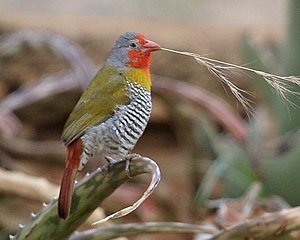Stripes
| Stripes | ||||||||||||
|---|---|---|---|---|---|---|---|---|---|---|---|---|

Great red deer ( Pytilia melba ) |
||||||||||||
| Systematics | ||||||||||||
|
||||||||||||
| Scientific name | ||||||||||||
| Pytilia | ||||||||||||
| Swainson , 1837 |
Pytilia ( Pytilia ) is the name for a genus of the family of finches . There are four or five species described with numerous subspecies , all of which are unique to Africa.
description
Stripes reach a body length between eleven and 13 centimeters. All species have cross-banded plumage on the underside of the body. Rotmaskenastrild , Wienerastrild and Buntastrild have a red face mask, which the Auroraastrild lacks. The occurrence extends across Africa , south of the Sahara . In the case of the aurora tres, the distribution area runs as a narrow strip through the southern part of the dry savannah , the red-masked tiger occurs in the West African savannah area. Both species occur only sporadically in large parts of their range. The Wienerastrild colonizes East Africa including the island of Zanzibar .
The Buntastrild has the greatest distribution, for which ten currently recognized subspecies are described. They are separated into a red-lined and a gray-lined subspecies group. The distinction is made not only through the plumage color, but also through very differentiated song patterns in both groups, which prevent hybridization in contact zones.
Wienerastrild, Auroraastrild and Rotmaskenastrild stay mainly in trees and bushes, but also go to the ground to forage. The foraging for food on the ground is somewhat more pronounced in the Buntastrild. The whitefish is the least social bird among the stripes. It lives mostly in pairs and only occurs in small family groups at the end of the breeding season. The diet of all four striped branch consists largely of insects . The clutch consists of two to six white-shell eggs. Stripes are breeding hosts of widow birds of the genus Vidua (formerly Steganura ).
attitude
All four or five species were already kept in Europe in the 19th century, but play a relatively minor role in ornamental bird keeping. Their specific nutritional requirements contribute to this. Caring for them requires a wide range of animal feed materials. While the great spotted and aurora trildes usually like to eat wax moth larvae, Wiener trilde usually reject them and have to be fed with frozen ant pupae during the winter months. They are also incompatible birds during the breeding season and can therefore only socialize with conspecifics or other fine finch to a limited extent. They are unsuitable for keeping in cages and require spacious indoor aviaries. In small numbers, wild-caught stripes regularly come into the trade, but are often in poor health due to inappropriate nutrition during transport. All species are bred in small numbers in Europe.
species
The following four or five species and subspecies belong to the striped branch:
-
Great red deer Pytilia melba (Linnaeus, 1758)
- Pytilia melba melba (Linnaeus, 1758)
- Pytilia melba citerior Strickland, 1853
- Pytilia melba flavicaudata Welch & Welch, 1988
- Pytilia melba soudanensis (Sharpe, 1890)
- Pytilia melba jessei Shelley, 1903
- Pytilia melba belli Ogilvie-Grant, 1907
- Pytilia melba percivali Someren, 1919
- Pytilia melba grotei Reichenow, 1919
- Pytilia melba thamnophila Clancey, 1957
- Pytilia melba hygrophila Irwin & Benson, 1967
- Wienerastrild Pytilia afra (Gmelin, 1789)
-
Aurora reef Pytilia phoenicoptera Swainson, 1837
- Pytilia phoenicoptera phoenicoptera Swainson, 1837
- Pytilia phoenicoptera emini Hartert, E, 1899
- Striped bark Pytilia lineata Heuglin, 1863 (recognized both as a subspecies of Pytilia phoenicoptera and as an independent species).
- Red masked deer Pytilia hypogrammica Sharpe, 1870
supporting documents
literature
- Jürgen Nicolai (Ed.), Joachim Steinbacher (Ed.), Renate van den Elzen, Gerhard Hofmann, Claudia Mettke-Hofmann: Prachtfinken - Afrika , Series Handbuch der Vogelpflege, Eugen Ulmer Verlag, Stuttgart 2007, ISBN 978-3-8001- 4964-3
- Howard, R., Moore, A. & EC Dickinson (2003): The Howard and Moore Complete Checklist of Birds of the World . Princeton University Press, Rev. and Enl. 3rd Ed. ISBN 978-0691117010
- Nicolai, J. (1977): The red masked tiger (Pytilia hypogrammica) as host of the Togo paradise widow (Steganura togoensis) . J. Orn. 118: 175-188.
Web links
Single receipts
- ↑ Nicolai, J. (1977): The Rotmaskenastrild (Pytilia hypogrammica) as host of the Togo paradise widow (Stegonura togoensis) . J. Orn. 118: 175-188
- ↑ Nicolai et al., P. 58
- ↑ Nicolai, p. 63
- ↑ https://avibase.bsc-eoc.org/species.jsp?lang=DE&avibaseid=C08C7F959E44E626
- ^ Howard, R., Moore, A. & EC Dickinson (2003): The Howard and Moore Complete Checklist of Birds of the World . Princeton University Press, Rev. and Enl. 3rd Ed. ISBN 978-0691117010
